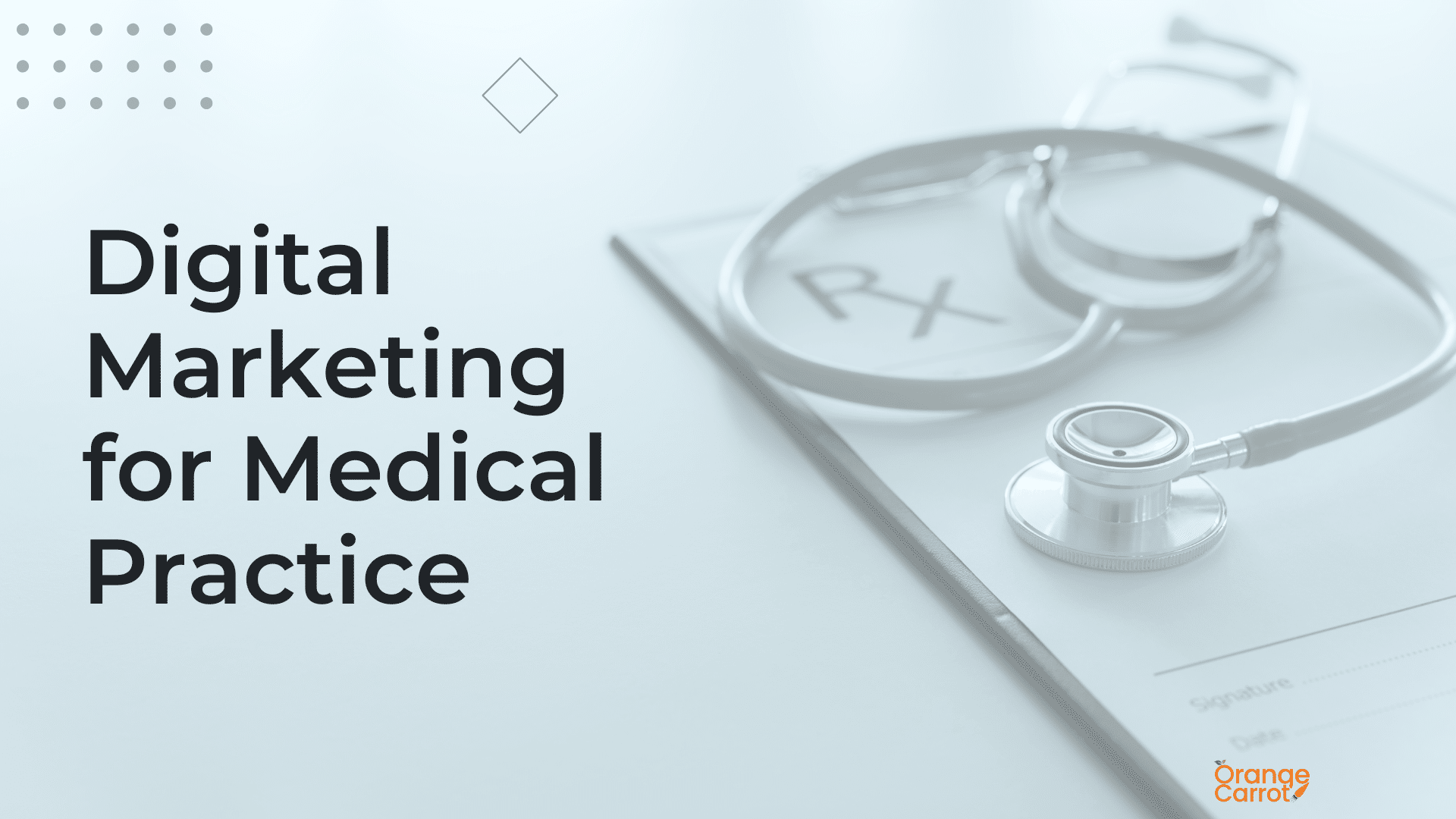
It’s a question many doctors quietly ask themselves after clinic hours: “We offer quality care, patients are happy… So why aren’t we growing?”
The uncomfortable truth is being a great medical practitioner doesn’t automatically make you a visible one. Clinical excellence, while non-negotiable, is no longer enough to build a thriving practice.
Today, your next patient may never walk through the door; not because they visited another doctor, but because they never even found you in the first place.
Let’s pause there.
According to Think With Google, over 77% of patients now begin their healthcare journey online; often by searching for symptoms, provider types, or specific services in their area. And yet, most independent medical practices invest the majority of their efforts into operational efficiency (billing systems, staff training, better equipment) while spending little to no time on discoverability (marketing).
If Google doesn’t know you exist, neither will your patients.
It’s debatable but undeniable.
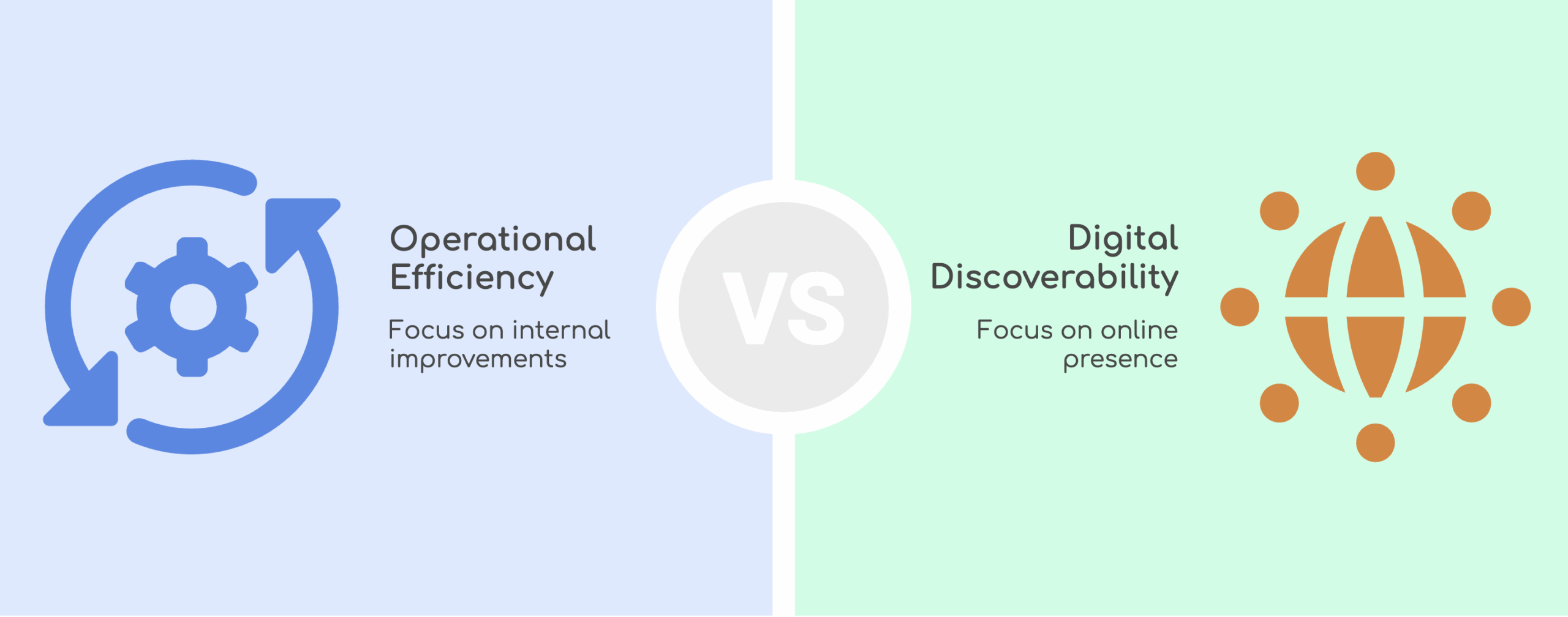
This is where digital marketing becomes not just a growth lever but a survival and thriving tool.
But here’s the challenge: most healthcare providers either outsource their marketing to generic agencies or put together a few tactics like Facebook posts or a monthly newsletter, hoping it sticks. This scattershot approach misses the deeper understanding of what healthcare marketing has become:
It’s not about selling services – it’s about being present in the moments when patients are uncertain, anxious, or actively seeking help.
When you miss those digital touchpoints, you miss the opportunity to build the trust that converts browsers into bookings.
In this blog, we’re not going to discuss another list of “10 SEO tips” with you. Instead, we’re going to talk about:
Because if you can master what happens before the patient ever calls you, you won’t have to chase growth; it will come to you.
If the modern patient begins their healthcare journey online, the next natural question is: where exactly do they start, and what influences their next step?
The answer is in understanding the digital patient pathway – a behavior now studied not only by marketers but by healthcare systems, insurers, and even panels at conferences like HIMSS (Healthcare Information and Management Systems Society) and HLTH (Health Innovation Conference).
This journey isn’t linear anymore.
It’s episodic, emotional, and fragmented across digital platforms.
Patients don’t just search for doctors; they search for answers.
According to a 2024 report by PLU, approximately one-third (33%) of Americans always search their symptoms online before seeking healthcare advice. This represents a large segment of the population who regularly search online to understand their health issues, such as “burning sensation when urinating” or “chronic shoulder pain” etc.
Google Trends show similar data: “why does my back hurt when I breathe” has over 1,000 monthly searches in the US alone.

At this stage, your practice doesn’t need to scream “We’re the best urologists!”. It needs to appear when the patient is vulnerable, confused, and seeking treatment.
Once a potential patient has identified they need medical attention, they shift to the evaluation phase, often unconsciously. Here, your practice credibility isn’t built with credentials alone; it’s transferred through trust signals across multiple digital channels like:
All of these elements provide emotional reassurance; signaling that this doctor’s practice has a strong presence, making them feel confident about booking an appointment.
At the Mayo Clinic Conference on Digital Healthcare Transformation (2022), one panelist summarized it best: “We’re no longer just designing access points, we’re designing moments of digital empathy.”
Let’s say a prospective patient has found your practice, trusts your clinic brand, and decides to book. If this next moment introduces friction like slow websites, confusing CTAs, no online scheduling, they’re gone.
A report from LLCBuddy shows that 28% of patients have either moved or stopped visiting a medical provider due to a poor online customer experience. Even if they had high trust in the physician, it didn’t work.
What matters at this point isn’t just your qualifications – it’s user convenience.
All these aspects determine a lot about the success of your medical practice: both online and offline.
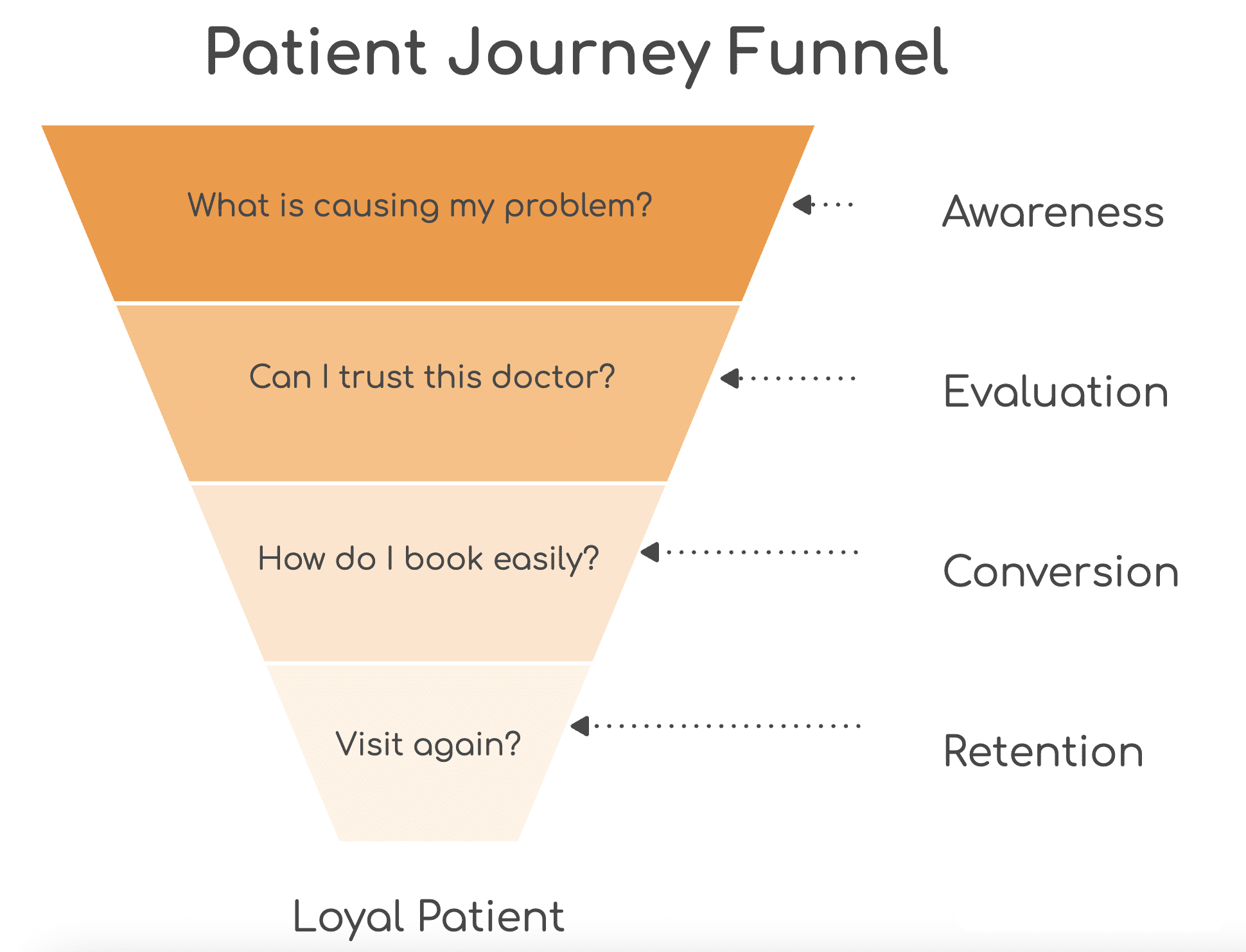
Let’s align this digitally influenced journey to a framework your team can act on:
| Phase | Patient Intent | Marketing Implication |
| Awareness | What is causing my problem? | SEO-optimized blogs, YouTube videos, symptom content |
| Evaluation | Can I trust this clinic/doctor? | Reviews, social media storytelling, provider bios |
| Conversion | How do I book easily? | Online booking, text/chat, fast-loading pages |
| Retention | Should I come back? | Email reminders, after-visit care, satisfaction surveys |
This is the new marketing funnel for modern medical practices.
It doesn’t start with your service list. It starts with your patient’s real experiences, and the subtle digital cues they rely on to get treated and supported.
We will later see why this can be slightly different for each speciality.
Up next, let’s look at how practitioners can design their digital strategy around these stages. We’re going to discuss how a stage-based acquisition framework is built; that’s both patient-centered and growth-driven.
Local intent dominates early search. Google’s own data show that U.S. mobile queries containing “near me today/tonight” grew by 900% in just two years by 2023. Health-related services are part of that surge, highlighting how proximity influences provider choice.
This is a direct indicator to optimize your website for “near me” keywords.
Apart from that, technical signals also amplify the local reach. Mobile-first websites are no longer optional since Google’s full roll-out of mobile-first indexing (in July 2023). Adding other elements like medical schema (LocalBusiness, MedicalOrganization and FAQ schema etc) improves the chance of rich-result eligibility, which is linked to visible CTR increase in healthcare.
And don’t forget the two strongest local-pack ranking factors = consistent NAP + 5 recent Google reviews. Try to acquire at least 5 patient reviews on Google per month; to maintain this status.
While organic visibility builds long-term credibility, pay-per-click (PPC) advertising delivers immediate results when patients need care urgently.
Google Ads for local medical services can place your practice at the top of search results for high-intent keywords like ‘urgent care near me’ or ‘orthopedic surgeon consultation.’
Social media advertising on Facebook and Instagram allows precise targeting based on demographics, health interests, and geographic location. LinkedIn ads work particularly well for B2B medical networking and specialist referrals.
The key with PPC is balancing immediate visibility with cost-effectiveness – most medical practices see positive ROI when acquisition costs stay below $150-250 per booked appointment.”
Connect with us to get a customized marketing plan for your medical practice.
Visibility will place your practice on the map, but trust determines whether a visitor becomes a patient.
Public-facing proof points do the heavy lifting here. And the single biggest one is online reviews. In Software Advice’s Master Patient Experience survey, 71% of respondents said they read reviews as the very first step when looking for a new doctor. Even more striking, 43% would go out of network (and pay more) if a highly-rated provider’s reviews looked better than an in-network alternative.
Simply put – online reputation is important. Your first as a medical practitioner, therefore, is to maintain authentic reviews; and to surface them anywhere a prospective patient might be looking. Be it Google Business Profile, Healthgrades, or your own physician-bio pages.
Important online directories for medical practitioners including Google Business Profile, Yelp for local reviews, Vitals and RateMDs for physician ratings, Zocdoc for online appointment booking, and Healthgrades. These platforms act as the internet’s Yellow Pages for healthcare industry.
Pro Tip: a provider bio is not a CV. Lead with patient-centred statements (“I help adults regain pain-free mobility”) before listing board certifications.
Ok so you’ve come this far and maintained a good online review profile. Then comes the patients’ hunt for evidence of clinical competence. That evidence can be shown in well-written provider bios, treatment-explainer articles, before-after images etc. These are the assets that let people “meet” the doctor before setting foot in the clinic.
Finally, every trust signal must link smoothly to an action like booking an appointment. Ratings widgets, bio stories, and blog posts etc., should all carry a one-click route to real-time scheduling, secure messaging, or at least a tap-to-call button.
In other words, the goal of Stage 2 isn’t to “market”. It’s to remove doubt, answer unasked questions, and make the yes decision effortless.
71% of consumers start with online reviews; 80% prefer providers that offer online appointment booking and scheduling.
As we established above, every digital asset should have a clear and easy CTA. Self-service is the new expectation from patients.
Also keep in mind that speed converts!
A multi-site ophthalmology clinic’s study (published in CRST Global) reported that responding to digital inquiries within 5 minutes doubled the conversion rate from enquiry to appointment.
Every minute after that saw a steep, almost exponential drop-off in conversion chances. This clearly highlights the value of real-time text, chatbot, or call-back automations. These are the AI-powered services that Orange Carrot offers to medical practitioners and doctors.
Apart from this, some small but impactful things to add to the website are to add a clickable phone number, having a 6 or less required fields in any form and a live-chat or SMS widget for after-hours triage.
These steps help to remove hidden friction in the entire appointment scheduling process.
Even a well-funded marketing plan will not work if one of three things aren’t right: conversion, scaling, or consistency.
Think of these as the vitals you read on a patient chart: traffic, trust signals, and flow. A quick check tells you where to intervene and what treatment will actually move the revenue needle.
If Google Analytics shows solid sessions yet your phone stays quiet, the problem is rarely “awareness”. It’s conversion friction or trust deficit. The Unbounce 2024 Conversion Benchmark Report says the average conversion rate for “Medical Practitioners” landing pages at 3.6%, with top performers going past 7%.
Anything markedly below that suggests leaks like: slow mobile load times, forms asking for a novel’s worth of information, or generic copy that fails to reassure anxious visitors.
Heat-map a few high-traffic pages, check bounce rates, and tighten call-to-action placement before you buy more clicks.
Reputation without reach is like a billboard in a basement.
Software Advice’s latest patient-review study found that 71% of patients start their provider search by reading reviews, and 43% will even go out-of-network for a doctor whose testimonials look stronger.
If your patient testimonials are on third-party sites, embed it (with HTML markup) on service pages, feature it in Google Posts, and use fresh reviews into social reels. Visibility turns static praise into compounding referrals.
Steady patient acquisition is less about heroic spikes and more about guarding the baseline visibility.
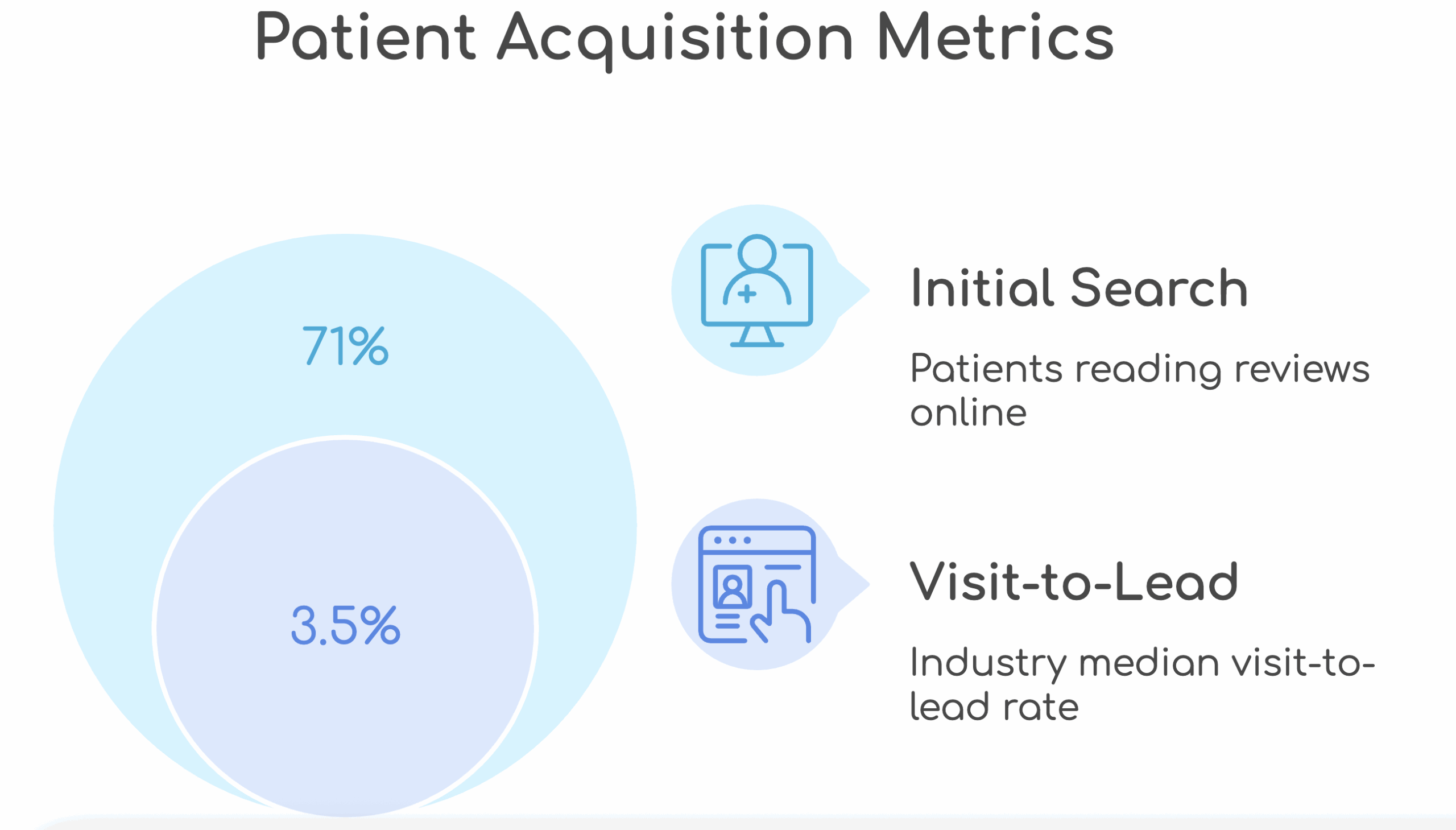
Run this four-metric audit every quarter:
Remember to track these important performance metrics (KPIs) beyond the practice pulse check:
Marketers love data points and bulletproof credentials, but patients are moved to take action by stories that make them feel something.
That’s why the most effective content strategies in healthcare aren’t product sheets but narrative campaigns. Modern “content marketing” is less about broadcasting facts and more about incorporating the empathy element in all forms of content (SEO-optimized blogs, videos etc).
Take Cleveland Clinic’s short film Empathy: The Human Connection to Patient Care.
The video generated around 8 million organic views and helped establish the hospital as an authority. Because the two-minute narrative invites viewers to “see” through a patient’s eyes rather than recite awards or rankings.
It is still listed among the 18 most influential healthcare campaigns of all time.
Similar emotional campaign “6th Annual Lollipop Super Hero Reveal” where children fighting chronic illness are photographed in custom capes and movie-poster poses. This is covered by People magazine and dozens of regional outlets routinely.
Such campaigns can be a great add-on to the routine clinical announcements; because the imagery reframes vulnerability as courage, giving parents and donors a story worth sharing.
Visual-first channels amplify the story-based marketing narratives. Healthcare agency round-tables now cite Instagram and TikTok as the fastest-growing venues for emotional storytelling. Short reels of a NICU nurse’s day, or a 60-second “before/after” anxiety-recovery video.
A 2025 multimodal study of 398 TikTok mental-health videos found that narrative devices (first-person voice, on-screen text, micro-cuts) consistently drove higher engagement than just purely informational clips.
Even a humble SMS can carry emotional weight. Appointment follow-ups that include a single line like – “How are you feeling after yesterday’s procedure? Text me any concerns”. These generate responses that email can’t touch.
Other social media platforms for creating impact:
Instagram and TikTok remain the fastest-growing venues for emotional storytelling, while LinkedIn helps establish professional credibility.
A word of caution here.
“I don’t trust doctors who post on social media” is a popular sentiment on Instagram and TikTok in the USA. To top that, a University of Chicago analysis found 44% of TikTok videos about sinusitis contained misinformation, a level of bad‐info exposure that only amplifies distrust in any medical advice found on those platforms.
Clinicians who prioritize social-media content creation may inadvertently compromise clinical availability. U.S. patients face an average “third next available” appointment wait of 38 days versus a 14-day industry benchmark. Moreover, a JAMA Network Open study found influencers, including some physicians, emphasize benefits of medical tests in 87% of posts while mentioning potential harms in only 6% of them.
So, while social media buzz can boost your brand, it’s important to balance promotional content with ethical and professional accountability. Avoid chasing “viral doctor” status or producing videos solely for commercial gain.
Being consistent is just enough.
Below is an example of one of our podiatrists, for whom we create and post content consistently. Some of these views got converted into patients. But didn’t actually make him “viral”.
So, yes – storytelling does fall under the “content creation and content marketing” pillar of digital marketing. But if executed well, it is more than content; it’s the emotional infrastructure that lets every downstream tactic (SEO, ads, email) convert a little better because the audience already feels connected.
People may or may not recall your board certifications. But they will replay (in their minds or their feeds) the moment you turned a frightened child into a caped crusader or showed genuine empathy in a 15-second reel.
Design those moments, and the metrics will follow.
One of the most powerful initiatives practitioners can employ is to devote a small, predetermined share of marketing gains to community health projects like: screening camps, charity tele-consultations, or local wellness workshops. There’s a lot of emotional value in these types of programs. People may not remember incidents, but they’ll definitely remember the emotions it evoked.
The result is a fly-wheel: your practice grows, the community benefits, and the goodwill feeds back into brand trust and referrals.
Beyond storytelling, systematic trust-building requires:
Winning a new patient is the priciest part of the funnel. The average U.S. acquisition cost at $150–$250 per booked appointment depending on speciality and market. This includes media and staff time.
That spend only pays off if the relationship lives beyond the first encounter!
Retention marketing is therefore not an optional “Phase 2”; it is the profit engine that begins the moment someone fills the intake form.
Let us do the marketing while you concentrate on your practice. Book a free strategy call with us.
Unbounce’s 2024 Conversion Benchmark Report makes the case starkly: landing-page traffic that arrives via email converts almost 2× higher than paid search and paid social for health-and-wellness brands.
Why?
Because the inbox is permission-based, personal and segmented by default. This is one of the channels patients trust when they’re deciding whether to book, re-book, or recommend.
Tactically, that means every EMR discharge note should trigger a post-visit email sequence:
These touches keep the practice top-of-mind without resorting to “salesy” promos. And because they’re automated, they scale even for single-provider clinics.
Email is powerful, but it works best as part of a comprehensive content approach:
We discussed earlier that a typical patient behavior loop looks something like this:
Awareness → Consideration → First Consultation → Follow-Up → Repeat Visit
But lifetime value loop is slightly different, so the flow would be:
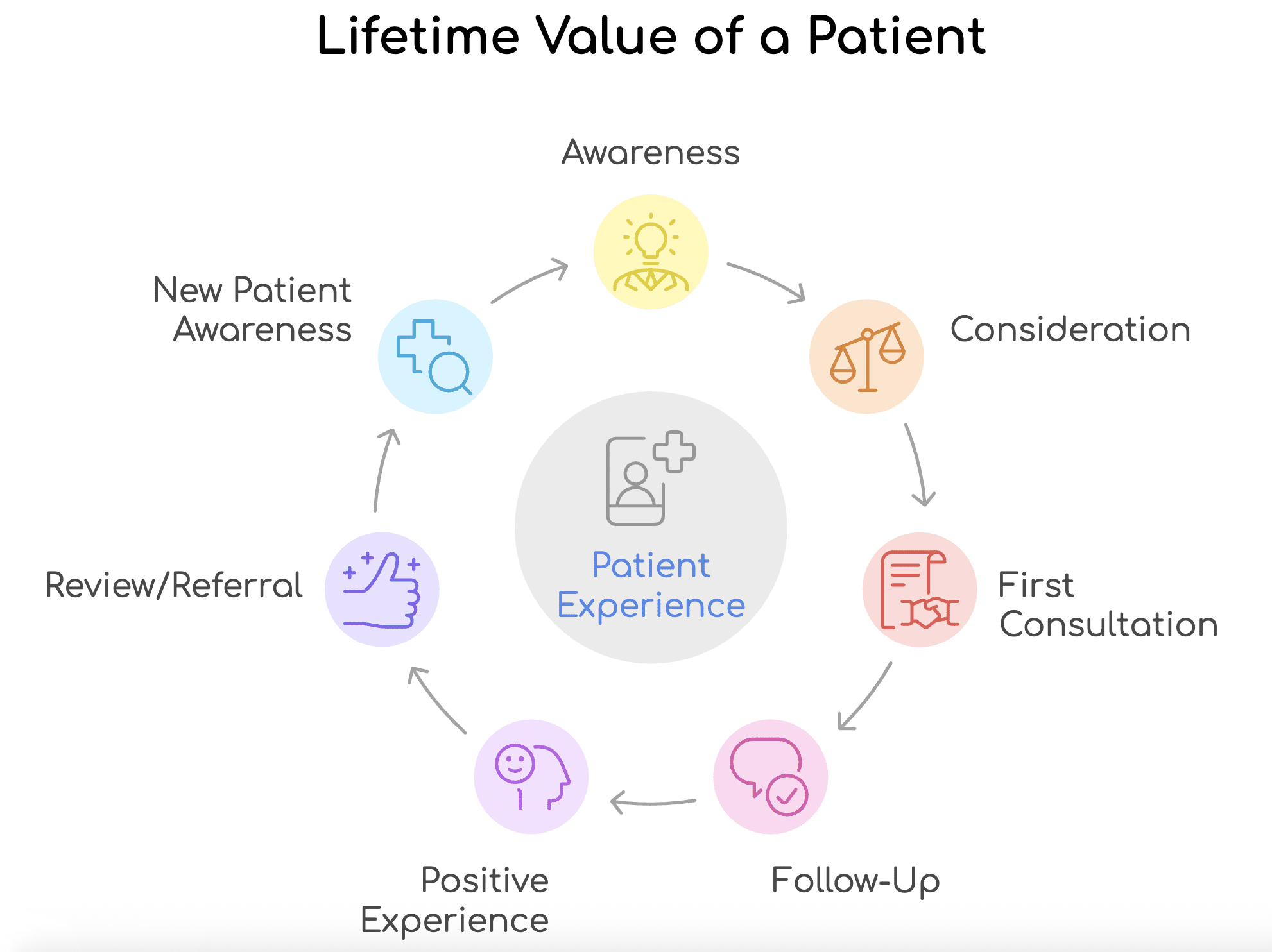
Notice “repeat visit” isn’t hard-wired into our loop. That’s because in many specialties (like orthopaedics, dermatologic surgery, dental implants), the ideal clinical outcome is that the patient doesn’t need to come back. They can if they need to. But what matters is that they:
For chronic-care specialities (mental health, endocrinology, physiotherapy etc) the loop becomes:
Awareness → Consideration → First Consultation → Follow-up → Adherence → Progress check-in → Next-stage care.
But the process is similar: deliver timely value so the patient chooses you before Google ever re-enters the picture.
Get an exclusive marketing plan for your practice. Book a free strategy call with us.
Metrics that indicate good retention are:
When these numbers lag, revisit the cadence and content relevance. Because, as shown in Section 5, emotion and story remain the hooks. Master those inside the inbox, and your acquisition stretches further month after month.
Great clinicians diagnose first, offer treatment, and monitor outcomes. Exceptional marketing follows the same discipline:
Do that consistently and you’ll spend less chasing clicks and more time delivering care to a waiting list of patients who already believe you’re the right choice.
Paid platforms publish the math in plain sight: a $500 monthly budget on either Meta or Google will barely buy a few thousand impressions in most U.S. metros – enough for brand awareness, not enough for a steady flow of booked appointments.
I am appalled by the way other healthcare marketing agencies offering “all-in” packages can’t cover media costs, creative, management, reporting, and compliance. Ending up cutting corners. There’s little to zero long-term value achievable with such low budgets. The research is evident: The average U.S. acquisition cost at $150–$250 per booked appointment.
I am pretty sure those agencies aren’t defining the right goals for medical practitioners with such budgets.
Our decade experience in healthcare marketing shows that a sustainable full-funnel marketing strategy typically ranges $1,500–$2,500 per month, inclusive of ad spend, CRO, and analytics.
Even within a single niche like podiatry (for example), business objectives are different. One Florida podiatrist asked for “more footfall” to his clinic, another wanted only surgical candidates.
Both strategies succeed because each is built on a distinct USP and UVP. So, define your practice’s USP-UVP early on. And the market is still wide-open, with room for specialty providers to dominate local search and referral channels.
Many corporate platforms (like Patient Pup) bundle hosting, ads, and analytics into a single dashboard you never truly control.
One of our clients approached us frustrated: limited data exports, no ownership of their own patient data, web assets, and costly termination clauses.
Orange Carrot works the opposite way. You retain full admin rights to ad accounts, websites, and all your first-party data. Should you ever move on, the transition is a hand-over, not a rebuild!
Share:
Download FREE Podiatry Marketing Plan Template